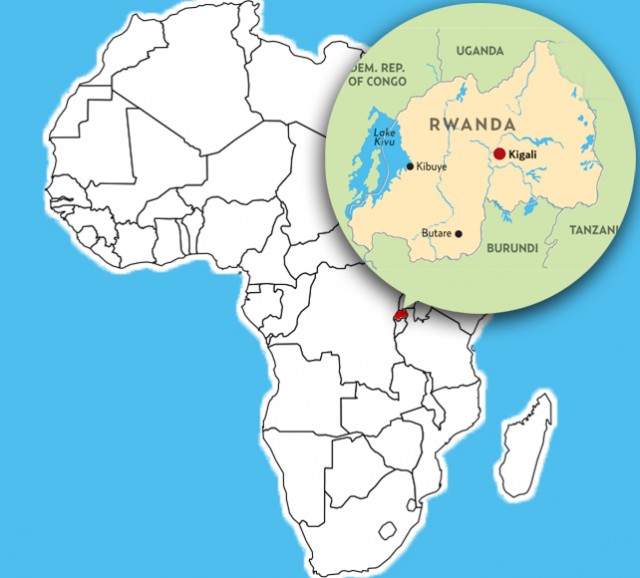Rwanda
Area 16,365 square mi (26,338 square km)
Population 11.34 million (2014)
Capital Kigali
Highest Point 14,826 ft (4,519 m)
Lowest Point 3,100 ft (950 m)
GDP $7.890 billion (2014)
Primary Natural Resources gold, cassiterite (tin ore).
RWANDA, LOCATED in Central Africa, is a landlocked country of savanna GRASSLAND with a population that is predominantly rural. It is bordered by BURUNDI, the Democratic Republic of the CONGO, TANZANIA, and UGANDA.
The terrain is generally grassy uplands and hills with mountains extending southeast from a chain of volcanoes in the northwest. The climate is temperate with two rainy seasons from February to April and November to January. Frost and snow can occur in the mountainous regions. The country is troubled by the prospect of deforestation that is occurring as a result of unimpeded cutting of trees for fuel, overgrazing by livestock, overuse of farm land, and erosion. Additional environmental and climate difficulties include poaching, droughts, and volcanic activity in the Virunga Mountains.

The ethnic and cultural makeup of the Rwandan people is: Hutu, 84 percent; Tutsi, 15 percent; and Twa Pygmoid 1 percent. Rwanda is the most densely populated country in Africa. Sixty percent of the population lives below the poverty line. Estimates for life expectancy in Rwanda take into account the effects of excess mortality rates from an uncontrolled AIDS epidemic, which significantly lowers the life expectancy, causes higher infant mortality and death rates, and lowers the population and growth rates.
This has changed the distribution of population by age and sex. The current life expectancy for the total population is 39 years. Roman Catholicism is the primary religion, practiced by 56 percent of the population; Protestant, 26 percent; Adventist, 11 percent; Muslim, 4.6 percent; indigenous beliefs 0.1 percent; and 1.7 percent claim no religious beliefs. Rwanda is a poor rural country with about 90 percent of the population engaged in subsistence agriculture. The main industries include cement production, agricultural products, small-scale beverages, soap, furniture, shoes, plastic goods, textiles, and cigarettes. Agriculture products that are produced include coffee, tea, pyrethrum (insecticide made from chrysanthemums), bananas, beans, sorghum, potatoes, and livestock. Products that are used for foreign trade are coffee and tea. The 1994 war and genocide destroyed Rwanda's already delicate economy and even further served to impoverish the population. Rwanda has made little progress in economic recovery. Despite Rwanda's fertile land, food production often does not meet the needs of population growth.
Three years before its independence from BELGIUM, in 1959, the Hutus, who are the majority ethnic group, overthrew the ruling Tutsi king. Over the next few years, thousands of Tutsis were killed, and 150,000 were driven into exile and escaped to neighboring countries. The children of these exiles later formed a rebel group, the Rwandan Patriotic Front, and started a civil war in 1990. This war, along with political and economic instability, aggravated ethnic tensions, resulting in the April 1994 genocide of roughly 800,000 Tutsis and Hutus. The Tutsi rebels defeated the Hutu regime and ended the killing in July 1994. This time, 2 million Hutus, many fearing Tutsi retribution, fled to neighboring Burundi, Tanzania, Uganda, and other countries. Subsequently, many of the refugees have returned to their homes.
Despite substantial international assistance and political reforms, including Rwanda's first local elections in 1999 and presidential and legislative elections in 2003, the country continues to be divided. Tutsi, Hutu, Hema, Lendu, and other conflicting ethnic groups, political rebels, armed gangs, and various governmental forces continue to fight, crossing into the borders of Burundi, the Democratic Republic of Congo, and Uganda to gain control over populated areas and natural resources. In spite of government and United Nations efforts to end the conflicts, localized violence continues.